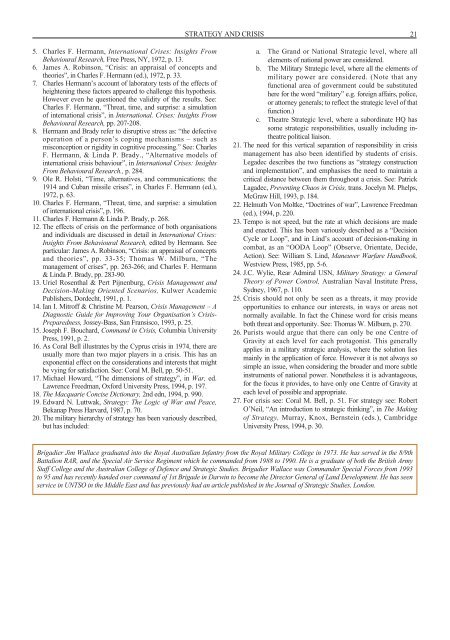ISSUE 136 : May/Jun - 1999 - Australian Defence Force Journal
ISSUE 136 : May/Jun - 1999 - Australian Defence Force Journal
ISSUE 136 : May/Jun - 1999 - Australian Defence Force Journal
- No tags were found...
You also want an ePaper? Increase the reach of your titles
YUMPU automatically turns print PDFs into web optimized ePapers that Google loves.
STRATEGY AND CRISIS215. Charles F. Hermann, International Crises: Insights FromBehavioural Research, Free Press, NY, 1972, p. 13.6. James A. Robinson, “Crisis: an appraisal of concepts andtheories”, in Charles F. Hermann (ed.), 1972, p. 33.7. Charles Hermann’s account of laboratory tests of the effects ofheightening these factors appeared to challenge this hypothesis.However even he questioned the validity of the results. See:Charles F. Hermann, “Threat, time, and surprise: a simulationof international crisis”, in International. Crises: Insights FromBehavioural Research, pp. 207-208.8. Hermann and Brady refer to disruptive stress as: “the defectiveoperation of a person’s coping mechanisms – such asmisconception or rigidity in cognitive processing.” See: CharlesF. Hermann, & Linda P. Brady., “Alternative models ofinternational crisis behaviour”, in International Crises: InsightsFrom Behavioural Research., p. 284.9. Ole R. Holsti, “Time, alternatives, and communications: the1914 and Cuban missile crises”, in Charles F. Hermann (ed.),1972, p. 63.10. Charles F. Hermann, “Threat, time, and surprise: a simulationof international crisis”, p. 196.11. Charles F. Hermann & Linda P. Brady, p. 268.12. The effects of crisis on the performance of both organisationsand individuals are discussed in detail in International Crises:Insights From Behavioural Research, edited by Hermann. Seeparticular: James A. Robinson, “Crisis: an appraisal of conceptsand theories”, pp. 33-35; Thomas W. Milburn, “Themanagement of crises”, pp. 263-266; and Charles F. Hermann& Linda P. Brady, pp. 283-90.13. Uriel Rosenthal & Pert Pijnenburg, Crisis Management andDecision-Making Oriented Scenarios, Kulwer AcademicPublishers, Dordecht, 1991, p. 1.14. Ian I. Mitroff & Christine M. Pearson, Crisis Management – ADiagnostic Guide for Improving Your Organisation’s Crisis-Preparedness, Jossey-Bass, San Fransisco, 1993, p. 25.15. Joseph F. Bouchard, Command in Crisis, Columbia UniversityPress, 1991, p. 2.16. As Coral Bell illustrates by the Cyprus crisis in 1974, there areusually more than two major players in a crisis. This has anexponential effect on the considerations and interests that mightbe vying for satisfaction. See: Coral M. Bell, pp. 50-51.17. Michael Howard, “The dimensions of strategy”, in War, ed.Lawrence Freedman, Oxford University Press, 1994, p. 197.18. The Macquarie Concise Dictionary, 2nd edn, 1994, p. 990.19. Edward N. Luttwak, Strategy: The Logic of War and Peace,Bekanap Press Harvard, 1987, p. 70.20. The military hierarchy of strategy has been variously described,but has included:a. The Grand or National Strategic level, where allelements of national power are considered.b. The Military Strategic level, where all the elements ofmilitary power are considered. (Note that anyfunctional area of government could be substitutedhere for the word “military” e.g. foreign affairs, police,or attorney generals; to reflect the strategic level of thatfunction.)c. Theatre Strategic level, where a subordinate HQ hassome strategic responsibilities, usually including intheatrepolitical liaison.21. The need for this vertical separation of responsibility in crisismanagement has also been identified by students of crisis.Legadec describes the two functions as “strategy constructionand implementation”, and emphasises the need to maintain acritical distance between them throughout a crisis. See: PatrickLagadec, Preventing Chaos in Crisis, trans. Jocelyn M. Phelps,McGraw Hill, 1993, p. 184.22. Helmuth Von Moltke, “Doctrines of war”, Lawrence Freedman(ed.), 1994, p. 220.23. Tempo is not speed, but the rate at which decisions are madeand enacted. This has been variously described as a “DecisionCycle or Loop”, and in Lind’s account of decision-making incombat, as an “OODA Loop” (Observe, Orientate, Decide,Action). See: William S. Lind, Maneuver Warfare Handbook,Westview Press, 1985, pp. 5-6.24. J.C. Wylie, Rear Admiral USN, Military Strategy: a GeneralTheory of Power Control, <strong>Australian</strong> Naval Institute Press,Sydney, 1967, p. 110.25. Crisis should not only be seen as a threats, it may provideopportunities to enhance our interests, in ways or areas notnormally available. In fact the Chinese word for crisis meansboth threat and opportunity. See: Thomas W. Milburn, p. 270.26. Purists would argue that there can only be one Centre ofGravity at each level for each protagonist. This generallyapplies in a military strategic analysis, where the solution liesmainly in the application of force. However it is not always sosimple an issue, when considering the broader and more subtleinstruments of national power. Nonetheless it is advantageous,for the focus it provides, to have only one Centre of Gravity ateach level of possible and appropriate.27. For crisis see: Coral M. Bell, p. 51. For strategy see: RobertO’Neil, “An introduction to strategic thinking”, in The Makingof Strategy, Murray, Knox, Bernstein (eds.), CambridgeUniversity Press, 1994, p. 30.Brigadier Jim Wallace graduated into the Royal <strong>Australian</strong> Infantry from the Royal Military College in 1973. He has served in the 8/9thBattalion RAR, and the Special Air Service Regiment which he commanded from 1988 to 1990. He is a graduate of both the British ArmyStaff College and the <strong>Australian</strong> College of <strong>Defence</strong> and Strategic Studies. Brigadier Wallace was Commander Special <strong>Force</strong>s from 1993to 95 and has recently handed over command of 1st Brigade in Darwin to become the Director General of Land Development. He has seenservice in UNTSO in the Middle East and has previously had an article published in the <strong>Journal</strong> of Strategic Studies, London.

















